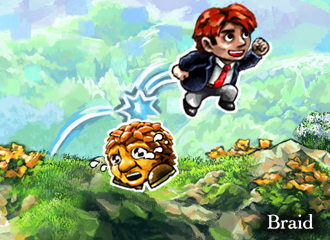By Jo Kim

When I first heard that we are going to be playing a platform game in class, the first thought that came into my mind was ‘Well, this is going to be easy,’ but boy, was I wrong. Going into the game, I was half-expecting Braid to be similar to the Super Mario Brothers series. Having played the said game over and over past the years of my life, I thought having a good gaming reflex would help me breeze through the levels of Braid.
Truly enough, the first introductory phase of Braid proved to be what I expected, a typical reflex-based platform game; however, I did notice that Braid had a special tint to its game play, the narrative, which separated this game from its other platform counterparts. However, as I progressed past the initial introduction part, I realized that Braid required more cerebral activity than games like Super Mario Brothers or I Wanna Be The Guy. Braid was closer to a puzzle-type game than it was a reflex-based game.
Collecting puzzles proved to be a rather difficult task, as I had to plan out what to do in order to get the puzzle in the levels. However, thanks to the Braid’s unique feature of “time-reversal” I was able to do these tasks without starting over from the scratch whenever I “died” from controlling errors. This “time-reversal” (pressing shift to reverse for yourself, or walking backwards to reverse time for everything) gradually proved itself as a significant feature of the game, as you needed it to defeat bosses and collect puzzles. It was quite difficult getting used to this feature, as the usage of this ability seemed to differ from level to level, requiring more thinking and preparations.
Having collected all the puzzles in the first level, I did not receive any type of “reward” for my hard work (other than the picture, which I did not care about for the most part, and because of this, I deduced that the puzzles in this game might be similar to coins in Super Mario Brothers or in Sonic the Hedgehog. Following this, from the next level on, I tried to finish the level as fast as possible without collecting these puzzles, as I was more interested in the narration (the dialogue between Tim and the black dinosaur intrigued me for some reason, do not ask why). As I went further and further in the story, I got hooked into it, and I wanted to see the ending; however, this is when the puzzles got me. Because I had not collected any puzzles past level 1, I was not able to proceed into the final level, making all my work of running straight through the levels meaningless. But it was perfectly fine, as I had the internet to dig into the ending.
Overall, Braid proved to be a familiar, yet a fresh approach into the platform gaming field. Its melancholy artwork and background music created a dreamy atmosphere in the game, which allowed me to focus into the game much more. However, its puzzle-based gameplay proved to be a bit too much for me, as my brain does not possess such delicate feature. Nonetheless, the gaming experience was enjoyable, and I recommend it to puzzle-lovers and platform-lovers, as you can kill two birds with one stone by playing this game. For story lovers, the narration in this game is outstanding as well (I can vouch this because I looked at the ending on Wikipedia played the game) and the twist at the end is flavorful. When I have leisure, I will definitely go back and finish the game, just so I can say that I have played the game thoroughly.


Haha, loved how you crossed out words — almost emphasized them more and really made the post funny.